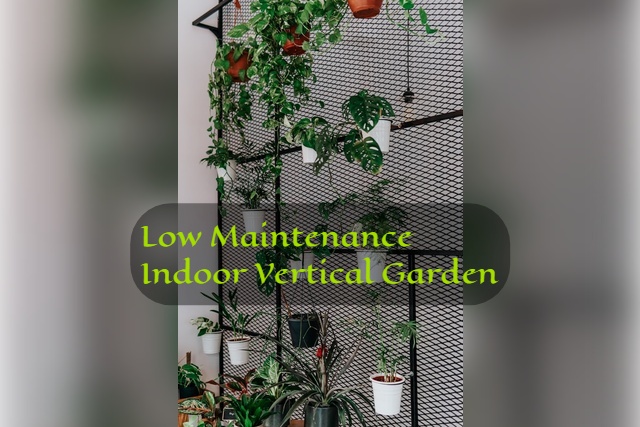Have you ever imagined having a lush, green oasis inside your home without sacrificing valuable floor space? An indoor vertical garden makes this possible by allowing you to grow plants vertically rather than horizontally. Whether you’re living in a small apartment or simply want to enhance your interior with greenery, a vertical garden is the perfect solution.
In this comprehensive guide, we’ll explore how you can set up a low maintenance indoor vertical garden, choose the best plants, and ensure its long-term success. With the right knowledge, anyone can turn their indoor space into a stunning, self-sustaining garden.
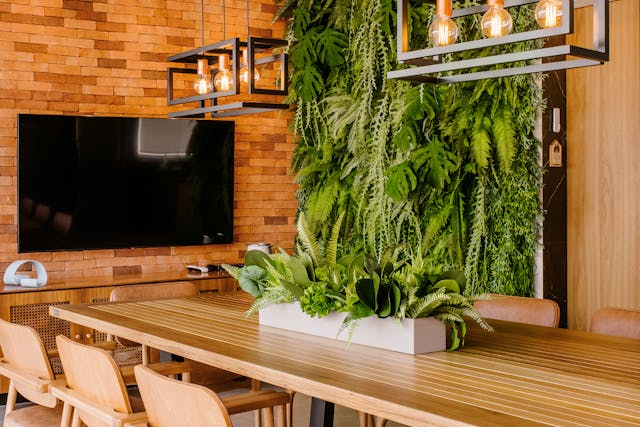
Why Choose a Low Maintenance Indoor Vertical Garden?
Not everyone has the time or expertise to care for a demanding garden. That’s where a low maintenance indoor vertical garden comes in handy. With the right plant choices and setup, you can enjoy the beauty of nature indoors without constant upkeep.
A low maintenance approach means choosing self-sufficient plants, using efficient watering systems, and minimizing the need for pruning or replanting. This makes vertical gardening accessible to everyone, even those with the busiest schedules.
Related Article: Small Space Indoor Garden Design
The Benefits of an Indoor Vertical Garden
1. Space-Saving Solution
One of the biggest advantages of a low maintenance indoor vertical garden is that it maximizes space. Instead of using up precious floor area, plants grow upward on walls, shelves, or hanging structures.
2. Improves Air Quality
Indoor plants naturally purify the air by absorbing carbon dioxide and releasing oxygen. Certain plants, like peace lilies and snake plants, can also remove toxins, making your indoor environment healthier.
3. Aesthetic Appeal
A vertical garden enhances the visual appeal of any room. Whether you opt for a sleek modern look or a rustic wall of greenery, an indoor garden becomes a unique focal point.
4. Reduces Stress and Boosts Mood
Studies show that being around plants can reduce stress and promote mental well-being. Having a green space indoors can create a sense of calm and relaxation.
5. Increases Humidity
Indoor plants help regulate humidity levels, which can be particularly beneficial in dry climates or during winter when indoor air becomes dry.
Best Plants for a Low Maintenance Indoor Vertical Garden
Not all plants thrive in vertical gardens, especially if you want a low-maintenance setup. Here are some of the best options:
1. Succulents and Cacti
Succulents like jade plants and aloe vera require minimal watering and thrive in indoor environments with indirect sunlight.
2. Air Plants (Tillandsia)
These unique plants don’t need soil and absorb moisture from the air, making them perfect for vertical gardens.
3. Pothos (Devil’s Ivy)
Pothos is one of the most forgiving plants, thriving in both low light and bright conditions while requiring little maintenance.
4. Ferns
Boston ferns and maidenhair ferns add lush greenery and help increase indoor humidity.
5. Herbs (Basil, Mint, Thyme)
If you want an edible garden, herbs are a fantastic choice. They grow well in vertical planters and require minimal care.
Choosing the Right Location for Your Vertical Garden
The success of your low maintenance indoor vertical garden largely depends on its placement. Consider the following factors when choosing a location:
1. Light Availability
Most indoor plants need some degree of natural or artificial light. Position your vertical garden near a window or supplement it with LED grow lights if needed.
2. Temperature and Humidity
Ensure your garden is placed in a stable environment without extreme temperature fluctuations. Avoid placing it near air conditioners, heaters, or vents.
3. Accessibility for Maintenance
While your vertical garden is designed to be low maintenance, occasional watering and trimming will still be necessary. Choose a spot where you can easily reach the plants.
Essential Materials and Tools You Need
Setting up a low maintenance indoor vertical garden requires some essential supplies:
- Vertical Planters or Wall-Mounted Pots
- High-Quality Potting Mix
- Drip Irrigation System or Self-Watering Pots
- Grow Lights (If Natural Light Is Insufficient)
- Support Structure (Trellis, Shelves, or Hanging Planters)
- Fertilizer for Indoor Plants
Having these materials ready will make the setup process smooth and efficient.
Step-by-Step Guide to Setting Up a Vertical Garden
Step 1: Choose a Vertical Garden Design
Decide whether you want a wall-mounted garden, hanging planters, or a freestanding structure.
Step 2: Install a Support System
Use sturdy materials like wooden panels, metal grids, or shelving units to support your plants.
Step 3: Select Your Plants
Opt for low maintenance plants that suit your indoor environment and light conditions.
Step 4: Arrange and Plant
Organize your plants based on their sunlight and water needs, ensuring taller ones don’t overshadow smaller ones.
Step 5: Set Up a Watering System
Use self-watering pots or a drip irrigation system to reduce manual watering efforts.
Step 6: Maintain and Enjoy
Check for any signs of pests or overwatering periodically and enjoy your indoor greenery!
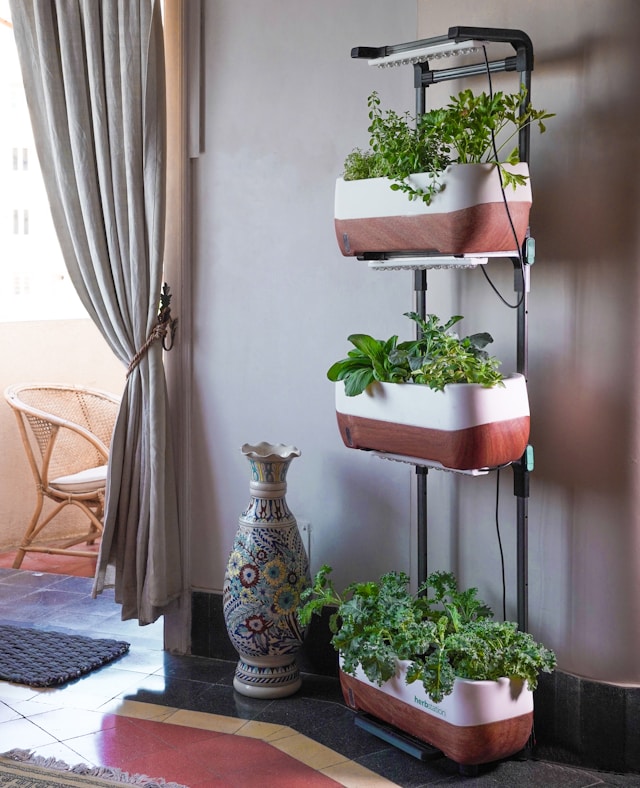
Hydroponic vs. Soil-Based Vertical Gardens: Which Is Better?
When setting up a low maintenance indoor vertical garden, you’ll need to decide between hydroponic and soil-based systems. Both methods have their advantages, so choosing the right one depends on your needs and preferences.
Hydroponic Vertical Gardens
Hydroponic gardens grow plants without soil, using nutrient-rich water instead. They are often easier to maintain because they eliminate soil-related issues like pests and overwatering.
Pros:
- Faster plant growth due to direct nutrient absorption
- Less mess since no soil is involved
- Requires less water than traditional gardening
Cons:
- Higher initial setup cost
- Needs a power source for water circulation
- More technical knowledge required
Soil-Based Vertical Gardens
Traditional soil-based gardens use potting mix and are more natural. They require minimal setup and work well with a variety of plants.
Pros:
- More natural and familiar gardening method
- Easier to set up with minimal equipment
- Works well with most indoor plants
Cons:
- Soil can attract pests
- Requires more frequent watering
- May lead to soil compaction over time
For a truly low maintenance indoor vertical garden, hydroponics may be a better option if you’re willing to invest in the setup. However, if you prefer a traditional approach, soil-based systems are still effective.
Lighting Requirements for an Indoor Vertical Garden
Proper lighting is essential for your low maintenance indoor vertical garden to thrive. Different plants have different light requirements, and understanding these needs will help you choose the best setup.
Types of Light for Indoor Gardens
- Natural Light
- Best for plants like succulents and herbs
- Requires placement near a bright window
- LED Grow Lights
- Energy-efficient and long-lasting
- Provides full-spectrum light for healthy plant growth
- Fluorescent Lights
- Budget-friendly option
- Works well for shade-loving plants like ferns
How to Optimize Lighting
- Place your vertical garden in a south-facing window for maximum natural light.
- Use grow lights if your space lacks sufficient sunlight.
- Rotate plants occasionally to ensure even light distribution.
If you want a low maintenance setup, using automatic grow lights with timers can reduce the hassle of monitoring your plants.
Watering Techniques for a Low Maintenance Garden
A low maintenance indoor vertical garden should have an efficient watering system to reduce the need for frequent manual watering.
1. Self-Watering Planters
These planters have a built-in reservoir that allows plants to absorb water as needed. They are perfect for busy individuals.
2. Drip Irrigation Systems
Drip irrigation delivers water directly to the roots in a controlled manner, preventing overwatering and reducing waste.
3. Water Retaining Soil
Using soil with good moisture retention (like coco coir or perlite mix) helps maintain consistent hydration levels.
4. Misting for Humidity-Loving Plants
For ferns and air plants, occasional misting keeps them hydrated without excessive watering.
By choosing the right watering method, you can significantly cut down maintenance efforts and ensure a healthy indoor garden.
Best DIY Indoor Vertical Garden Ideas
Want to create a low maintenance indoor vertical garden on a budget? Here are some creative DIY ideas:
1. Hanging Pocket Planters
Fabric pocket planters are affordable and easy to install on walls. They work great for herbs and small leafy greens.
2. Wooden Pallet Vertical Garden
Repurpose an old wooden pallet by attaching small pots and mounting it on a wall. It adds a rustic touch to your space.
3. Mason Jar Wall Garden
Use mason jars as plant holders and attach them to a wooden board for a stylish and functional indoor garden.
4. PVC Pipe Planters
Cut and arrange PVC pipes in a vertical pattern to create a modern and innovative planter system.
With a little creativity, you can build a stunning vertical garden that’s both low maintenance and budget-friendly.
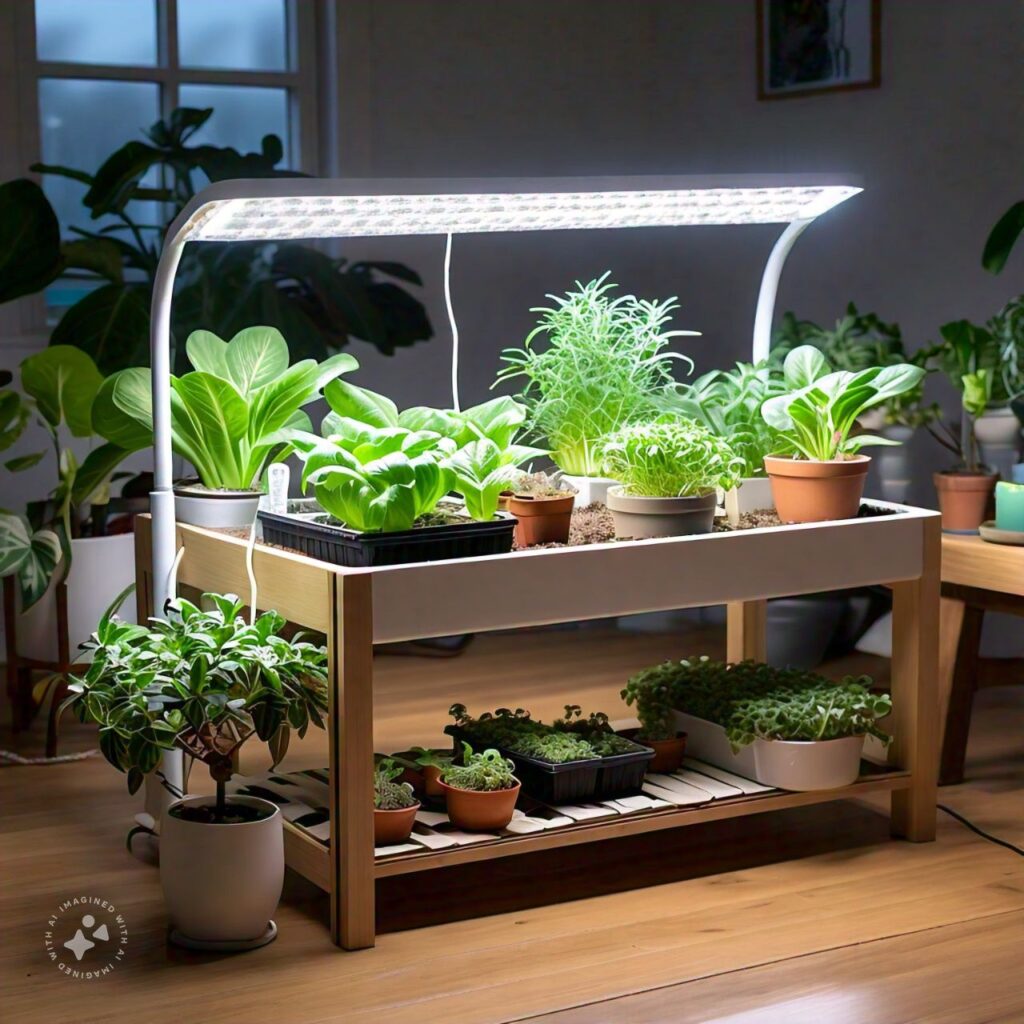
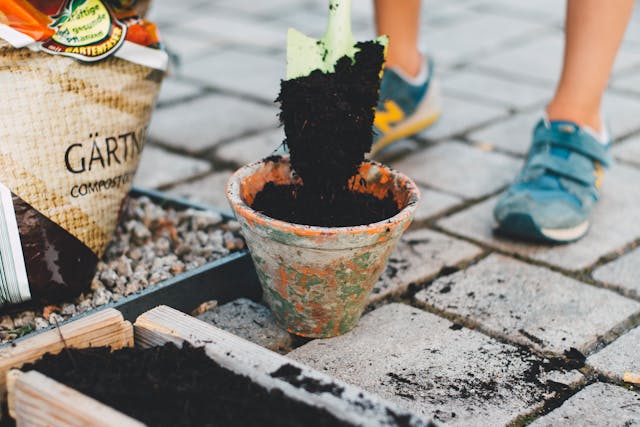
How to Prevent Common Problems in Vertical Gardens
Even a low maintenance indoor vertical garden can face issues. Here’s how to prevent common problems:
1. Overwatering or Underwatering
- Use self-watering pots or drip irrigation to maintain consistent moisture.
- Check soil moisture levels before watering.
2. Pest Infestations
- Use neem oil spray to prevent pests naturally.
- Regularly inspect plants for signs of bugs.
3. Poor Air Circulation
- Avoid overcrowding plants.
- Use a small indoor fan to improve airflow.
By taking proactive steps, you can ensure a thriving vertical garden with minimal upkeep.
Sustainable Practices for an Eco-Friendly Indoor Garden
Sustainability is key to a low maintenance indoor vertical garden. Here’s how to make your garden eco-friendly:
1. Use Recycled Materials
Opt for upcycled containers like old cans, wooden crates, or repurposed bottles for plant pots.
2. Collect Rainwater for Watering
If possible, collect and use rainwater to hydrate your plants naturally.
3. Choose Organic Fertilizers
Use compost, worm castings, or natural liquid fertilizers instead of chemical-based ones.
Sustainable gardening not only benefits the environment but also helps create a healthier indoor space.
Decorating with an Indoor Vertical Garden
A low maintenance indoor vertical garden can serve as both a functional garden and a decorative element. Here are some ways to incorporate it into your home:
1. Living Wall Art
Arrange plants in patterns to create a green wall masterpiece.
2. Kitchen Herb Garden
Mount a vertical herb garden in your kitchen for fresh herbs at your fingertips.
3. Bedroom Oxygen Boost
Place air-purifying plants in your bedroom to improve air quality and sleep better.
A well-designed vertical garden transforms your indoor space into a serene and stylish retreat.
Indoor Vertical Garden Maintenance Tips for Longevity
Even a low maintenance indoor vertical garden needs occasional care. Follow these tips to keep it thriving:
- Prune plants to remove dead leaves and encourage growth.
- Check for pests regularly and treat them early.
- Clean planters to prevent mold and fungus buildup.
- Rotate plants to ensure even growth.
With minimal effort, you can enjoy a lush, green space year-round.
Frequently Asked Questions About Indoor Vertical Gardens
1. How often should I water my vertical garden?
It depends on the plants, but most vertical gardens require watering once or twice a week.
2. Can I grow vegetables in an indoor vertical garden?
Yes! Leafy greens like lettuce, spinach, and kale do well in vertical setups.
3. Do vertical gardens attract pests?
Proper care and natural pest deterrents (like neem oil) can help prevent infestations.
4. What is the best lighting for an indoor vertical garden?
LED grow lights are ideal if your space lacks natural sunlight.
5. How can I make my vertical garden more sustainable?
Use organic fertilizers, recycled planters, and water-efficient systems.
6. Is a vertical garden high maintenance?
Not if you choose low maintenance plants and set up an automated watering system.
Conclusion: Transform Your Space with a Low Maintenance Indoor Vertical Garden
A low maintenance indoor vertical garden is an excellent way to add greenery to your home without the hassle of traditional gardening. By choosing the right plants, optimizing light and water systems, and incorporating sustainable practices, you can enjoy a thriving indoor garden with minimal effort.
Ready to create your own lush, vertical oasis? Start today and bring the beauty of nature into your home!

